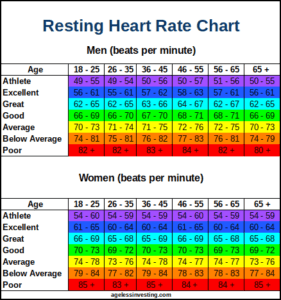Are you concerned about having a dangerous heart rate?
Your heart rate could become dangerous if it’s too high, too low, or irregular. Generally, a normal heart rate for adults is between 60 to 100 beats per minute.
But whether your heart rate is dangerous or safe depends on many factors.
Heart rate changes to adapt to your environment and physical needs.
Tracking your usual heart rate at rest and during exercise helps determine your dangerous heart rate. Any noticeable changes in your pulse rate could be an early warning sign of a serious heart problem.
In this article, you’ll learn about normal heart rates, the causes and symptoms of a dangerous heart rate, what affects your pulse, and how to lower your heart rate.
First, what is a normal heart rate?
What Is A Normal Resting Heart Rate?
A normal resting heart rate for adults is (1) between 60 beats per minute (bpm) and 100 bpm. But some people have heart rates outside this range, and they’re healthy. Athletes’ resting heart rates can range from 40 to 60 bpm.
A resting heart rate means that your heart is pumping the least amount of blood necessary to supply the oxygen your body needs. It’s your minimum heart rate.
The best time to take your resting heart rate is before you leave your bed in the morning. Coffee, smoking, activity, fever, and loud noises can raise your heart rate temporarily.
If your heart rate is outside of the 60 to 100 bpm range during exercise, it’s not usually dangerous. The AHA says a person can work harder (or lighter) depending on their target heart rate.

Normal Resting Heart Rate For Kids
The normal resting heart rate for children tends to be higher than for adults. As they grow, their heart rate usually slows down.
| Newborns 0 to 1-month-old | 70 to 190 bpm |
| Infants 1 to 11 months old | 80 to 160 bpm |
| Children 1 to 2 years old | 80 to 130 bpm |
| Children 3 to 4 years old | 80 to 120 bpm |
| Children 5 to 6 years old | 75 to 115 bpm |
| Children 10 years and older (and adults) | 60 to 100 bpm |
Data from the National Institute of Health:

What Is A Dangerous Heart Rate For Adults?
A heart rate could become dangerous if it’s too high (tachycardia), too low (bradycardia), or irregular. You should consult your medical provider if your resting heart rate is irregular or consistently outside the normal 60-100 bpm range. But your heart rate isn’t necessarily dangerous when it’s out of the normal range.
Your heart rate changes to adapt to your environment and activity level. Your heart rate may be above 100 bpm during exercise or below 60 when sleeping.
Generally, having a heart rate that’s too fast or slow is only dangerous when there isn’t an obvious cause.
It’s important to track your usual heart rate to help you and your medical provider determine what a dangerous heart rate is for you.
What Is A High Heart Rate?
A high heart rate, called tachycardia (tak-ih-KAHR-dee-uh), means your heart beats too fast. Generally, adults’ heart rate over 100 bpm is considered too fast (1). But what’s too fast depends on your age and physical condition. Generally, having a high heart rate is only dangerous when there isn’t an apparent cause.
Types of Tachycardia
Tachycardia types are classified based on the part of the heart they affect and their cause. Some of the most common types are the following (2):
- Atrial or Supraventricular Tachycardia (SVT)
- Sinus Tachycardia
- Ventricular Tachycardia
With tachycardia, your heart beats too fast due to health conditions unrelated to normal physiological stress. First, we will look at the temporary causes of tachycardia. Then, we’ll look at underlying long-term causes.
What Causes Tachycardia?
Tachycardia may be temporary, depending on the cause. It’s normal for your heart rate to increase during illness, stress, or trauma. Possible temporary causes of a high heart rate include (3):
- Anxiety or stress
- Heavy alcohol use
- Overuse of caffeine
- Drug use
- An electrolyte imbalance
- Infections
- Fever
- Intense exercise or physical activity
- Medication side effects
- Experiencing Pain
- Smoking cigarettes
Underlying Health Conditions That Raise Heart Rate
With tachycardia, your heart beats too fast due to a health condition unrelated to regular physiological stress.
- Anemia
- Congenital heart disease
- Heart Disease that affects blood flow
- Hyperthyroidism
- Heart injury: for example, a heart attack
- Ventricular or supraventricular arrhythmias
Can A High Heart Rate Cause Damage?
Without proper treatment, a heart rate that’s too fast can cause the following:(3)
- Cardiac arrest or death
- Chest pain
- Fainting or feeling dizzy
- Heart damage
- Organ failure
- Stroke
What Factors Affect Resting Heart Rate?
Besides your age, your resting heart rate is dependent on many factors. According to the American Heart Association, your heart rate can be affected by the following:
- Air Temperature: When the temperature and humidity rise, your heart needs to pump more blood. Your pulse may increase up to 5 to 10 bpm.
- Body position: Your heart rate is about the same whether sitting or standing. But when you stand, your pulse may increase for 15 to 20 seconds and return to normal within a few minutes.
- Body size: Relative to a smaller person, the heart of an obese person has to work harder (and beat faster) to pump blood to their whole body.
- Emotions: Stress or excitement can raise your heart to prepare your body for action.
- Medications that block adrenaline (beta-blockers) usually slow your heart rate. Also, a high dose of thyroid medication can raise your heart rate.
- Dehydration: Being dehydrated raises your pulse (3).
- Type 2 Diabetes is associated with heart rate (4).
- Alcohol, caffeine, and nicotine
- Pregnancy
- Hormonal changes
What Is A Low Heart Rate?
A heart rate that’s too low is called bradycardia, which is usually a heart rate below 60 bpm (4). A heart rate below 60 bpm could be dangerous for people who don’t exercise. However, a heart rate below 60 bpm is normal and healthy for athletes and those who exercise.
What Causes Low Heart Rate (Bradycardia)?
Bradycardia, or a slow heart rate, can be caused by the following:
- Aging
- An electrolyte imbalance
- Congenital heart disease
- Damage to the heart (from heart disease or heart attack)
- Chronic inflammation
- Hypotension (low blood pressure)
- Medication side effects
- Myocarditis (a heart infection)
- Problems with the heart’s conduction system
- Sleep apnea
Borderline or temporary bradycardia may not require treatment. However, consistent bradycardia left untreated can become more dangerous.
The underlying conditions determine whether a heart rate is dangerous. If you have heart disease or have a family history of heart disease, you should tell your doctor about any heart rate changes.
How To Take Your Pulse: Step-By-Step
The American Heart Association’s simple method for taking your pulse is the following:
- Find your pulse on the inside of your wrist (on the thumb side)
- With the tips of your index and middle finger, press your artery lightly
- Count your heartbeats for 30 seconds, and then multiply by two for your beats per minute
Consult your doctor if your resting heart rate is consistently fast or irregular.
When To Take Your Pulse
The best time to take your pulse depends on your purpose:
- Check your resting heart rate in the morning while you’re still in bed
- Check your maximum heart rate immediately after vigorous exercise
How to Lower Your Heart Rate
You can lower your heart rate both instantly and long term. Simple heart-healthy natural remedies may include:
- Stress Reduction. When stressed, your heart rate is high to prepare your body for action. Stress management techniques such as meditation, yoga, tai chi, or progressive muscle relaxation help your mind and body relax.
- Get better sleep. Your heart rate is slowest during sleep, letting your heart rest. Poor sleep quality or sleep apnea, a disease that can cause lapses in breathing during sleep, can affect your heart rate.
- Quit smoking. Generally, smokers have higher resting heart rates, but quitting smoking can bring them back to normal (5).
- Eat A Healthy Diet: A whole food plant-based diet rich in fruits, vegetables, and legumes lowers resting heart rate naturally, especially beans (6).
- Maintain a healthy weight: The larger the body, the harder the heart must work to circulate blood. Losing weight reduces your body size and reduces your resting heart rate.
- Stop drinking/reducing alcohol. Moderate alcohol consumption, such as a glass of wine a day, does not appear to increase your life expectancy (7). Alcohol also causes weight gain and disrupts sleep.
- Exercise regularly. Exercise can lower your resting heart rate by making your heart more efficient.
- Stay hydrated: Drinking water helps lower your heart rate and activates your parasympathetic nervous system (8).
- Limit Caffeine/energy drinks. Caffeine can raise your heart rate if you’re caffeine-sensitive and disrupt your sleep.
- Be aware of medication side effects. Some over-the-counter medications have stimulants that can raise your heart rate. Be aware of side effects and consult your doctor before taking medication.
- Try the Valsalva maneuver. Hold your nose, close your mouth, and try to blow air out hard. Learn how to perform the Valsalva maneuver in the short video below.
When To See A Doctor For Your Heart Rate
You should see a doctor if you experience any of the following:
- Your resting heart rate is consistently above 100 bpm
- Your heart rate is consistently below 60 bpm (and you’re not an athlete)
- Your resting heart rate changes suddenly
- Dizziness or Light-headedness
- Shortness of breath
- Fainting spells
- Heart palpitations (fluttering feeling your chest)
- Chest pain or discomfort
- Exercise intolerance
- A change in heart rate due to medication
You should also report any new or worsening symptoms for early detection.
When A High A Low Heart Rate Is an Emergency
Get emergency care if you experience any of the following:
- Chest pain or tightness
- Difficulty breathing for more than a few minutes
- Fainting
- Your heart rate stays above 100 bpm at rest
- Dizziness or light-headedness
What is Maximum Heart Rate?
Your maximum heart rate is the highest your heart rate can reach safely. Maximum heart rate equals 220 minus your age. If you’re 45, your maximum heart rate is 175 (220-45).
Knowing your maximum heart rate is important for two reasons.
- Exercising above your maximum heart rate can be dangerous.
- Exercising below your target heart rate means you’re not exercising hard enough.
What Is Target Heart Rate?
Target heart rate is a percentage range, generally between 50 and 85 percent, of your maximum safe heart rate (9). Both target and maximum heart rate decrease with age.
For example: If you are 35, your maximum heart rate is 185 bpm (120-35), and your target heart rate is 93(185×50%)–157(185×85%) bpm.
To calculate your target heart rate:
- Find your maximum heart rate: 220 minus your age
- Calculate your bottom 50% range: Divide your maximum heart rate by two
- Calculate your top 85% range: Multiply your maximum heart rate by 85%
| Years (Age) | Target Heart Rate (BPM) | Maximum Heart Rate (BPM) |
| 20 | 100 –170 | 200 |
| 30 | 95 –162 | 190 |
| 35 | 93 –157 | 185 |
| 40 | 90 –153 | 180 |
| 45 | 88 –149 | 175 |
| 50 | 85 –145 | 170 |
| 60 70 | 80 –136 75 – 128 | 160 150 |
Why Your Heart Rate Changes
Your heart rate changes to adapt to your environment or your activity level.
If you’re sedentary, your heart rate may increase to your target range just by walking.
As you exercise regularly, you’ll need more intense workouts to reach your target heart rate because your aerobic capacity is improving.
Aerobic capacity (10) is the maximum physiological work you can do as measured by oxygen consumption. It reflects your body’s ability to perform under stress for long periods. And a high aerobic capacity is associated with a lower risk of a heart attack.
Even a normal heart rate can be dangerous. If you never try to reach your maximum safe heart rate, your heart will weaken. Your heart may not be efficient enough to handle stress, including exercise.

What Is A Dangerous Heart Rate For A Woman?
A high resting heart rate of over 76 beats per minute is generally dangerous for a woman (11).
A study of 129,135 postmenopausal women evaluated resting heart rate as an independent indicator of heart health in women.
Trained observers measured the participant’s pulses at their wrists after the women sat quietly for 5 minutes.
Within eight years, 2,281 women had a heart attack or coronary death, and 1,877 had a stroke.
The researchers controlled for other factors using a self-reported questionnaire. Controlled factors are hypertension, alcohol and caffeine consumption, smoking, diabetes mellitus requiring dietary or drug therapy, and high cholesterol requiring drug treatment.
Resting heart rates ranged from 62 beats per minute (bpm) or less to greater than 76 bpm.
Women with a resting heart rate greater than 76 bpm or greater were 26% more likely to have a heart attack or die from one than women with a resting heart rate of 62 bpm or less.
These results were the same regardless of race or ethnicity. It was also independent of hypertension, diabetes, and cholesterol levels.
The researchers concluded that resting heart rate is a simple, inexpensive predictor of heart attack or coronary death but not stroke in women.
Is Your Heart Living Dangerously?
You’re worried that you or someone you love has a dangerous heart rate.
Now you know the normal heart rate range and when a heart rate is too fast or slow.
You also know when a fast or slow heart rate is safe and when it’s dangerous. Lastly, you know how to lower your heart rate naturally and when to seek medical attention.
Are you in the normal heart rate range?
If not, work with your medical provider to understand why and how to treat it.
Further Reading:
Resting Heart Rate Chart | What Is A Good Resting Heart Rate?
How To Lower Blood Pressure | 25 Natural Remedies
Sources Cited
- https://www.heart.org/en/health-topics/high-blood-pressure/the-facts-about-high-blood-pressure/all-about-heart-rate-pulse#.WTnI5DOZPaZ
- https://www.heart.org/en/health-topics/arrhythmia/about-arrhythmia/tachycardia–fast-heart-rate
- https://www.ncbi.nlm.nih.gov/books/NBK553128/
- https://www.ncbi.nlm.nih.gov/pubmed/27312000
- https://www.heart.org/en/health-topics/arrhythmia/about-arrhythmia/bradycardia–slow-heart-rate
- https://www.ncbi.nlm.nih.gov/pubmed/23089999
- https://pubmed.ncbi.nlm.nih.gov/26524703/
- https://www.ncbi.nlm.nih.gov/pubmed/19678777
- https://www.heart.org/en/healthy-living/fitness/fitness-basics/target-heart-rates
- https://medical-dictionary.thefreedictionary.com/aerobic+capacity
- https://www.ncbi.nlm.nih.gov/pmc/articles/PMC2640113/